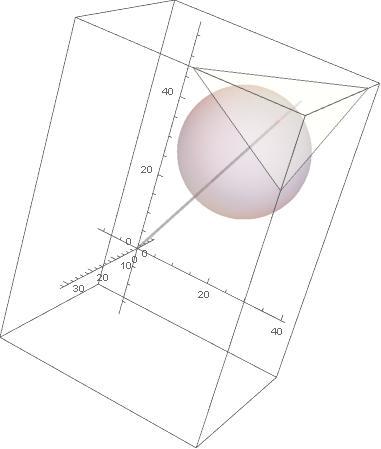You don't need 4 equations.
Determine d , given that the real numbers a , b , c , and d satisfy the equation below.
a 2 + b 2 + c 2 + 5 1 9 = d + 3 6 1 0 a + 1 4 b + 2 2 c − d
The answer is 66.
This section requires Javascript.
You are seeing this because something didn't load right. We suggest you, (a) try
refreshing the page, (b) enabling javascript if it is disabled on your browser and,
finally, (c)
loading the
non-javascript version of this page
. We're sorry about the hassle.
3 solutions
The situation is that of a sphere of radius 1 9 5 , the diagonal of a 5 × 7 × 1 1 box, centered at { 2 2 1 3 1 5 − 5 , 1 5 4 6 5 3 − 7 , 2 4 2 6 5 3 − 1 1 } tangent with an infinite plane at { 2 2 1 3 1 5 , 1 5 4 6 5 3 , 2 4 2 6 5 3 } . The origin, the sphere's center and the point of tangency are all in a straight line. The normal vector of the infinite plane is parallel to that straight line.

My actual solution was solve a 2 + b 2 + c 2 + 5 1 9 = 3 6 1 0 a + 1 4 b + 2 2 c − d + d for d getting ± 3 6 − a 2 + 1 0 a − b 2 + 1 4 b − c 2 + 2 2 c − 1 9 5 + a 2 + b 2 + c 2 − 1 2 9 and minimizing that expression to get { 6 6 , { a → 5 , b → 7 , c → 1 1 } } .
It took me longer to reconstruct the original situation.
Using the functions f ( a , b , c ) = a 2 + b 2 + c 2 + 5 1 9 and g ( a , b , c ) = 5 a + 7 b + 1 1 c , the problem writes as f = d + 3 6 2 g − d , which can easily be rewritten as a quadratic polynomial in d: d 2 + ( 3 6 2 − 2 f ) d + f 2 − 3 6 2 ( 2 g ) = 0 , which has solutions
d = 2 ( 2 f − 3 6 2 ) ± ( 3 6 2 − 2 f ) 2 − 4 ( f 2 − 3 6 2 ( 2 g ) ) .
Rework this to d = f − 6 4 8 ± 3 6 3 2 4 − f + 2 g .
Now the problem suggests that we can find a unique value for d, so we are going to assume that the discriminant D = 3 2 4 − ( a 2 + b 2 + c 2 + 5 1 9 ) + 2 ( 5 a + 7 b + 1 1 c ) has maximum value 0. Setting the derivatives of this expression with respect to a, b and c to 0 we get a = 5 , b = 7 , c = 1 1 , so that we find g = 1 9 5 and f = 7 1 4 . Trying it out we find
D = 3 2 4 − f + 2 g = 3 2 4 − 7 1 4 + 2 × 1 9 5 = 0 . The fact that this is indeed 0 justifies our earlier assumption.
Finally, d = 7 1 4 − 6 4 8 = 6 6 .
Add and subtract 1 0 a + 1 4 b + 2 2 c to the left side . Then Turn the right side to the left side .
You'll get :- a 2 + b 2 + c 2 + 5 1 9 + 1 0 a + 1 4 b + 2 2 c − 1 0 a − 1 4 b − 2 2 c − d − 3 6 1 0 a + 1 4 b + 2 2 c − d = 0
Complete to perfect squares:- ( a 2 − 1 0 a + 2 5 ) + ( b 2 − 1 4 b + 4 9 ) + ( c 2 − 2 2 c + 1 2 1 ) + ( ( 1 0 a + 1 4 b + 2 2 c − d ) − 3 6 1 0 a + 1 4 b + 2 2 c − d + 3 2 4 ) = 0
So , ( a − 5 ) 2 + ( b − 7 ) 2 + ( c − 1 1 ) 2 + ( 1 0 a + 1 4 b + 2 2 c − d − 1 8 ) 2 = 0
So we will get that a = 5 , b = 7 , c = 1 1 and 1 0 a + 1 4 b + 2 2 c − d = 1 8 , so 3 9 0 − d = 1 8 2 = 3 2 4 ,
d = 6 6 .